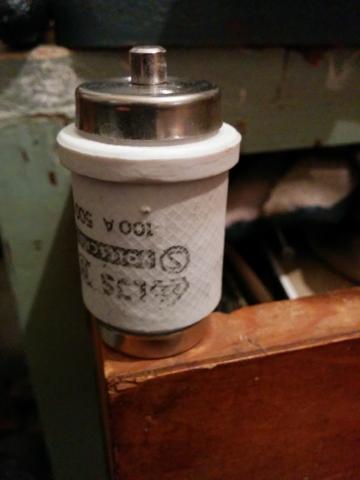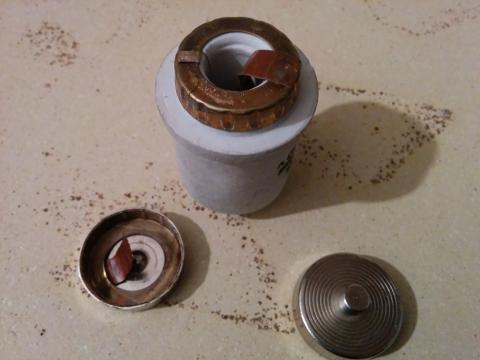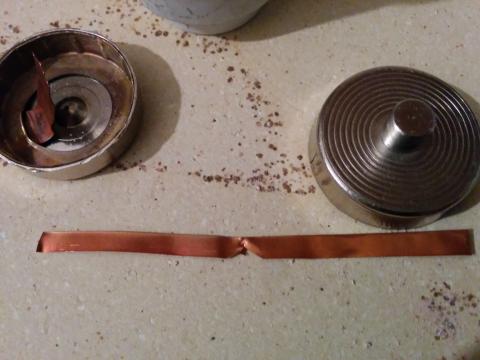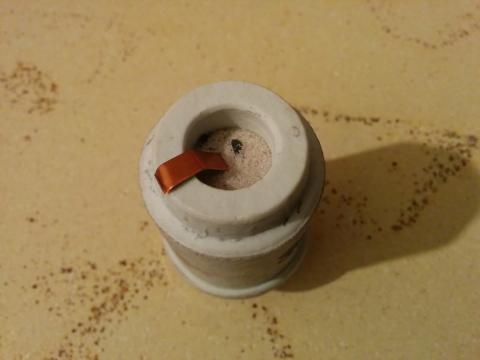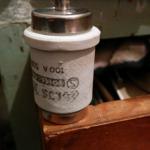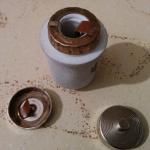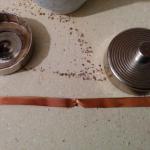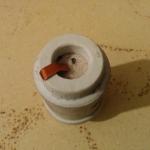Huge warning/disclaimer on this one, do not repair a fuse as it may result in property damage, fire, electrocution, injury, death, fatigue, loss of appetite, erectile dysfunction, nightmares, PTSD and/or diarrhea.
Having said that, do not do it unless you find your self in some kind of post apocalyptic scenario where you need to restore power to your oil refinery camp in order to defend your self against raiders.
 This fuse (actually 3 of them) are part of an electric installation powering a three-phase pottery furnace rated at about 60kW. Due to a faulty relay responsible for switching between Y and Δ configuration, two out of three phases where shorted to neutral. These fuses where rated at 100A each so when they blew, well, let's say there was light.
This fuse (actually 3 of them) are part of an electric installation powering a three-phase pottery furnace rated at about 60kW. Due to a faulty relay responsible for switching between Y and Δ configuration, two out of three phases where shorted to neutral. These fuses where rated at 100A each so when they blew, well, let's say there was light.
I started by removing the caps, there is silica and a copper ribbon inside the fuse.
In order to replace the copper ribbon (that's the fusing part of the fuse) i had to calculate the width of the copper ribbon.
Using the following table i calculated the copper width for 99A current by dividing the Area by the copper thickness.
Source: http://www.powerstream.com/wire-fusing-currents.htm
| AWG | Diameter in mm | Fusing Current for Copper Wire (Amps) | Area in mm² |
|---|---|---|---|
| OOOO | 11.684 | 3196 | 107.219302577 |
| OOO | 10.40384 | 2685 | 85.0114082563 |
| OO | 9.26592 | 2257 | 67.4321448791 |
| 0 | 8.25246 | 1897 | 53.4880465606 |
| 1 | 7.34822 | 1594 | 42.4086240423 |
| 2 | 6.54304 | 1339 | 33.6239732882 |
| 3 | 5.82676 | 1125 | 26.6651567947 |
| 4 | 5.18922 | 945 | 21.1492050492 |
| 5 | 4.62026 | 794 | 16.7657394525 |
| 6 | 4.1148 | 668 | 13.2980310814 |
| 7 | 3.66522 | 562 | 10.5509114164 |
| 8 | 3.2639 | 473 | 8.3668805717 |
| 9 | 2.90576 | 396 | 6.6314631936 |
| 10 | 2.58826 | 333 | 5.261452847 |
| 11 | 2.30378 | 280 | 4.1684240097 |
| 12 | 2.05232 | 235 | 3.3081107163 |
| 13 | 1.8288 | 198 | 2.6267715716 |
| 14 | 1.62814 | 166 | 2.0819647572 |
| 15 | 1.45034 | 140 | 1.6520741319 |
| 16 | 1.29032 | 117 | 1.3076295889 |
| 17 | 1.15062 | 99 | 1.0398093508 |
| 18 | 1.02362 | 82 | 0.8229385497 |
| 19 | 0.91186 | 69.6 | 0.6530496661 |
| 20 | 0.8128 | 58.6 | 0.5188684586 |
| 21 | 0.7239 | 49.3 | 0.4115731499 |
| 22 | 0.64516 | 41.5 | 0.3269073972 |
| 23 | 0.57404 | 34.8 | 0.258805912 |
| 24 | 0.51054 | 29.2 | 0.2047148886 |
| 25 | 0.45466 | 24.5 | 0.1623541434 |
| 26 | 0.40386 | 20.5 | 0.1281007178 |
| 27 | 0.36068 | 17.3 | 0.1021724961 |
| 28 | 0.32004 | 14.5 | 0.0804448794 |
| 29 | 0.28702 | 12.3 | 0.064701478 |
| 30 | 0.254 | 10.2 | 0.0506707479 |
| 31 | 0.22606 | 8.6 | 0.0401362994 |
| 32 | 0.2032 | 7.3 | 0.0324292787 |
| Metric 2.0 | 0.2 | 7.1 | 0.0314159265 |
| 33 | 0.18034 | 6.1 | 0.025543124 |
| Metric 1.8 | 0.18 | 6.1 | 0.0254469005 |
| 34 | 0.16002 | 5.1 | 0.0201112198 |
| Metric 1.6 | 0.16002 | 5.1 | 0.0201112198 |
| 35 | 0.14224 | 4.29 | 0.0158903465 |
| Metric 1.4 | 0.14 | 4.19 | 0.015393804 |
| 36 | 0.127 | 3.62 | 0.012667687 |
| Metric 1.25 | 0.125 | 3.54 | 0.0122718463 |
| 37 | 0.1143 | 3.09 | 0.0102608265 |
| Metric 1.12 | 0.112 | 3 | 0.0098520346 |
| 38 | 0.1016 | 2.59 | 0.0081073197 |
| Metric 1 | 0.1 | 2.53 | 0.0078539816 |
| 39 | 0.0889 | 2.12 | 0.0062071666 |
| 40 | 0.07874 | 1.77 | 0.0048694589 |
This chart of Fusing Currents for American Wire Gauge (AWG) wire sizes is data intended for the pleasure of our readers only. Typographical errors, etc. are probable. Please point out errors. The data listed are incomplete and should be used as a guideline only. Please contact manufacturers for the latest data.
Having calculated the appropriate width i cut a copper ribbon twice that size and reduced it's width at about half length, this way when the fuse blows i can make sure that the copper will fuse at this exact point.
Finally i put the silica back into the ceramic container and replaced the caps.
Did it work? Yes, it handled the current without blowing.
Ok but does it work? Actually yes, since conditions causing short circuit where not resolved, the fuse did blow, so...

